
Knowing how to promote your website online is the most important digital marketing skill to have these days. People consume online content through multiple channels, so it’s essential to plan ahead how you will reach out to them. You also need to take care of the needs of Google and other search engines. If search engine bots don’t find your business, barely anyone else will. Following SEO best practices is just as crucial as writing quality content and optimizing your website for speed.
In fact, successful digital marketing takes a lot of effort and a complex strategy. In this article, we have collected a bunch of tips about how to promote a website online, from doing keyword research to tracking performance statistics.
1. Do Keyword Research
People use language in different ways when they are looking for information in search engines. Keywords are the terms and phrases they enter into Google’s search bar before they run a query. The goal of keyword research is to find popular keywords relevant to your business and create targeted content that will rank organically for that term. When you have your target keywords you can spill them into blog posts, headlines, descriptions, and static pages on your site.
You can start keyword research manually. Enter relevant terms into the search bar and check out the related searches Google and Bing recommends at the bottom of each search results page. There are also online tools you can use to run a keyword research. The two best ones are Google AdWords’ Keyword Planner and Moz.com’s Keyword Explorer. They don’t only suggest keywords but also return key metrics such as monthly volume, difficulty, organic CTR, and others. Below, you can see Moz.com’s keyword suggestions for the “digital marketing” term, for the US market.
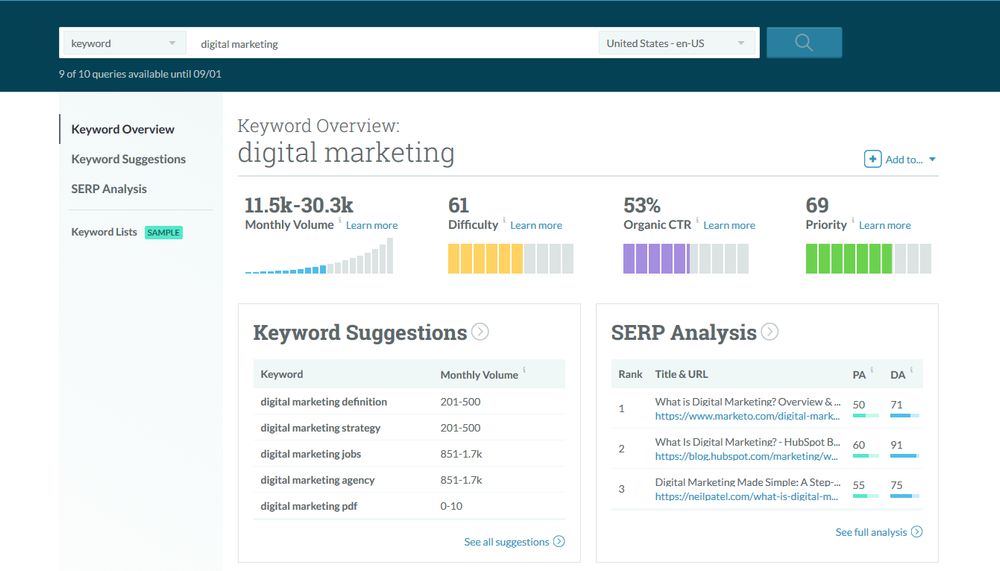
2. Create Quality Content
Starting a blog and creating quality content is increasingly important for SEO. Google has been emphasizing content quality as a ranking factor for a while. The recent update of the Google Hummingbird algorithm is said to be the most significant adjustment since 2001. It moves focus from target keywords to contextual relevance. While keywords are still important, you can’t ignore quality content anymore. These days you need to master the art of storytelling if you want search engines to find you. Google Webmasters also has an excellent Quality Guideline that details the principles to follow if you want your content rank well.
Content quality is also a key factor in social media that persuades users to share your posts or follow your account. Viral marketing, for instance, is unimaginable without providing your audience with engaging content. However, making your content interesting or witty is not enough anymore. High readability is just as crucial, as users tend to leave your site if they find your content too complicated. Readability is also becoming a big part of Google’s ranking algorithm. There are a number of tools with which you can check the readability of your content, such as the Hemingway App. As a rule of thumb, target Grade 9 or lower, as more complex texts cause troubles for many internet users.
3. Optimize Content for Google’s Featured Snippets
You can optimize your content to get into Google’s Featured Snippets as well. Featured Snippets are highlighted block elements at the top of search result pages. They have three major types:
1. paragraphs
2. lists
3. tables
For instance, here’s how Featured Snippets look like for the “best cheesecake recipe” search query. Although the “People also ask” section is not part of the official Featured Snippets, it frequently follows them on search result pages.
You can’t officially mark your content as a Featured Snippet, as Google determines them programmatically. However, if you research existing Featured Snippets within your niche market, you can make some guesses about the kind of content Google prefers.
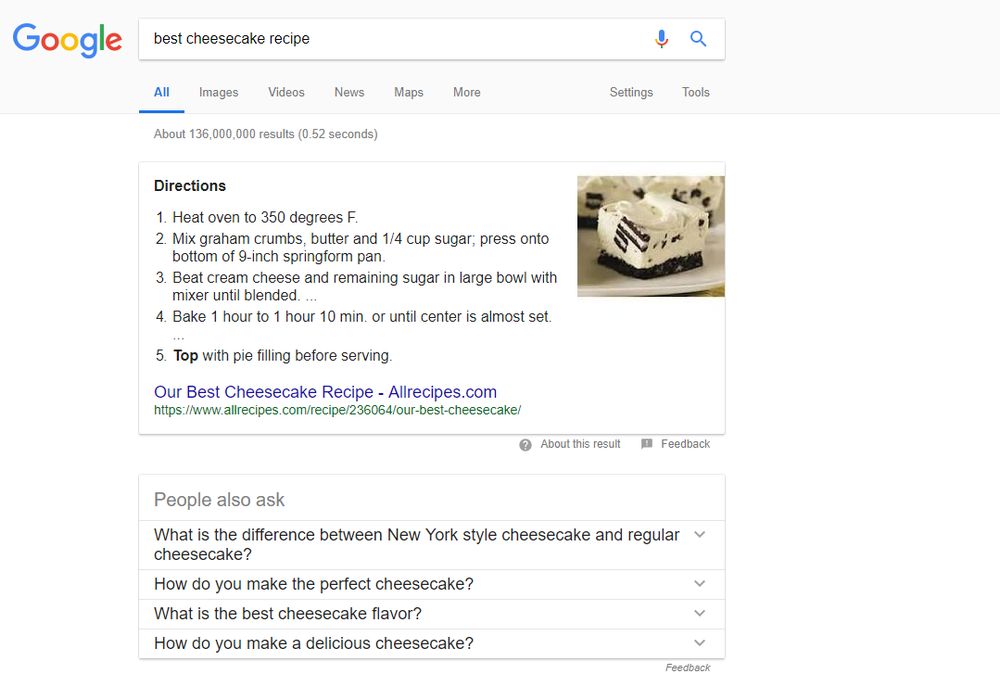
Researches collected by Moz.com claim that most Featured Snippets come from pages ranked in top 10, but not necessarily as #1. Headlines frequently use question format (“how?”, “what?”, “which?”) or include a comparison (“vs”, “versus”, “compared”). List type posts with instructions, such as the recipe above, also frequently appear in Feature Snippets. Manually researching Google can give you useful insights about how to promote your website in search engines.
4. Include and Optimize Images
Using eye-catching imagery is crucial if you want to engage your visitors. Especially, as image-focused social media sites such as Instagram and Pinterest are becoming increasingly popular these days. It’s also easier for readers to skim through your blog posts and articles if you occasionally break the text up with images. You can use your own photos, statistics, screenshots, infographics, or stock photos. Pixabay, Unsplash, and Pexels are examples of quality stock photo sites where you can download royalty-free images for free.
It’s important to optimize your images for the web as well. Today, more than half of your visitors browse your site on a mobile device. Large images load slowly on mobile, so always compress your images with tools like TinyPNG or TinyJPG. If you already have a working website you can also use SEOptimer to find the images that need optimization. You simply need to run SEOptimer’s reporting tool and scroll down to the “Optimize Images” section where you will find a list of poorly optimized images.
Don’t forget to pay attention to accessibility, either. Always add alt tags, descriptions, and titles to images, as people using screenreaders can’t access them otherwise. Besides, accessibility is also important for Google, especially if you want to get into image search results.
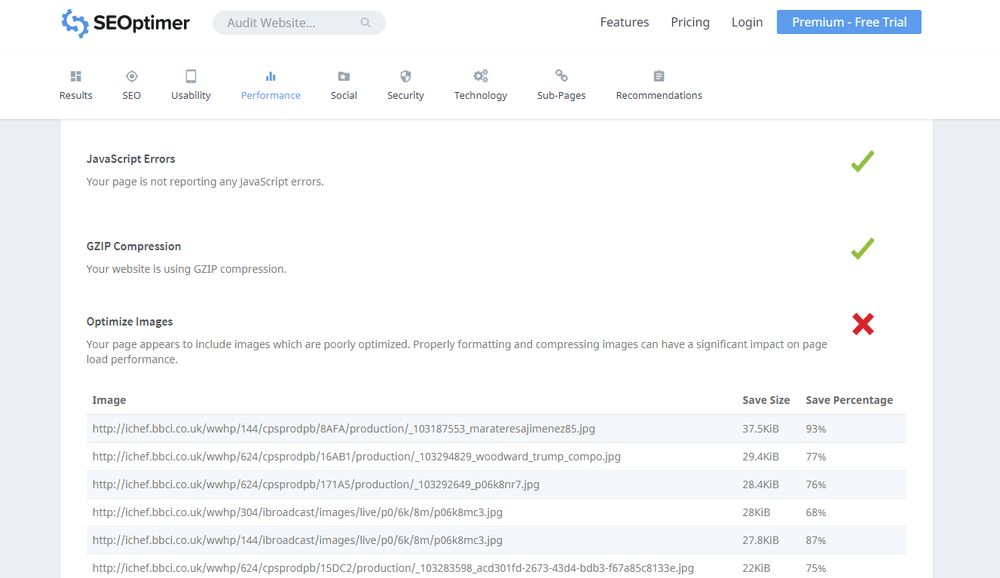
5. Build Strong Backlinks
Once upon a time, SEO was all about links. Although things have changed a lot since the first days of Google, backlinks are still essential if you want to successfully promote your website online. Backlinks or inbound links are links that point from other web pages to your site. On the other hand, outbound links are links that point from your site to other web pages. Backlinks are not only important because visitors are directed to your website, but they’re also a key deciding factor of search engines.
Not any link will be good for SEO, however. Google takes the following things into consideration when it evaluates a backlink:
- The backlink must come from a relevant website with similar content.
- It’s better if the link comes from a high-ranking and/or authority site. Backlinks from domains using the .edu, .gov, or .org extension are highly trusted by search engines.
- It’s better if the anchor text contains your keywords (e.g. “digital marketing tips” is a better anchor text than “click here”).
- It should be a dofollow link, meaning the related HTML tag shouldn’t contain the rel=”nofollow” attribute.
The best way to get backlinks is receiving natural links. This happens when other pages link to your site because you have awesome content. Besides natural links, you can get outreach links by reaching out to other websites in your niche and asking them to add links to your website. There are a few tested methods to do that in a persuasive way:
- Ask webmasters to link to your high-quality, relevant content that targets the same audience. Infographics, statistics, analyses, whitepapers are especially suitable here.
- Guest post on authority websites within your niche. Many high-ranking websites such as Entrepreneur, Forbes, and Hubspot have opportunities for guest bloggers.
- If you have a product ask popular bloggers or influencers to review it in exchange for a sample product, coupon, or fee.
- Submit your content to online directories such as Google My Business, Bing Places, and Yellow Pages. Here’s a great list by Wix.com of online directories where you can promote your website.
6. Promote Content Consistently on Social Media
Many website visitors arrive from social media sites nowadays. In fact, trust is the new currency in the digital age, which is one of the reasons behind the popularity of social media as well. People trust their friends more than search engines or ads, so they more likely follow links shared by people they know. Therefore, it’s crucial to promote your website on social media consistently.
Pick a couple of channels that fit well with your audience. There’s no general rule of thumb here. It takes some experimentation to figure out what works for your business. Only keep your profile on a social media site if it does generate leads and sales. There are a couple of metrics you can use to assess the success of a social media channel, such as referral traffic, click-through rates, and total reach. As an example, here is one of Twitter’s analytics pages with impressions and the 4-week engagement rate.
Regular posting is also important if you want to promote your website successfully on social media. There are several social media automation and lead generation tools you can use to automate certain tasks such as post scheduling. The most popular ones are Hootsuite, Buffer, and Crowdfire. However, don’t overdo it, as social media sites have begun to get serious about aggressive bot usage.
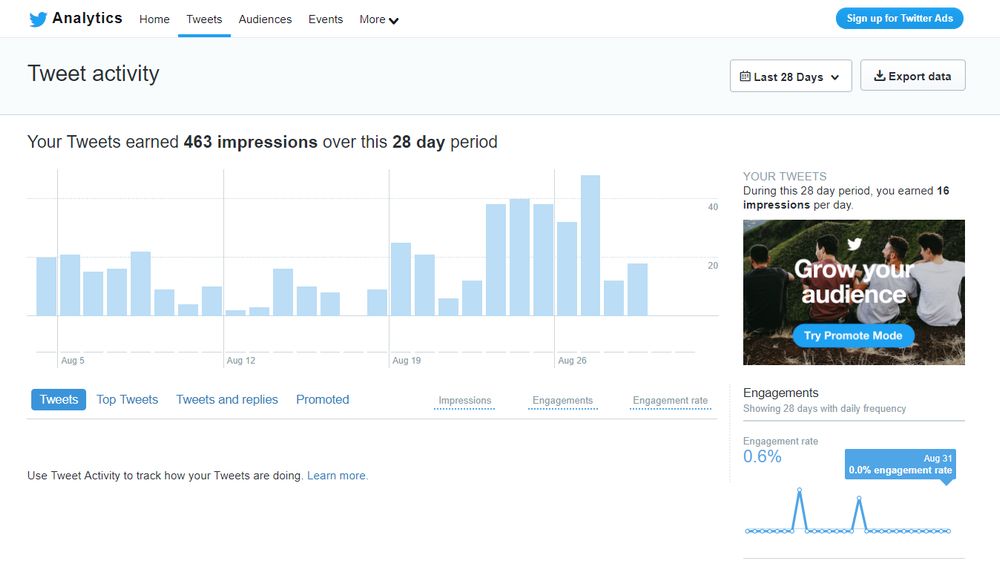
7. Post Diverse Content on Social Media
Although most people think of online content as articles, blog posts, and other text-based content, the social web is all about rich media. It refers to all kinds of content users can interact with, such as videos, audios, embedded apps, polls, and gifs. Besides rich media, visuals such as images, memes, and animations also further increase engagement on social media. All in all, if you want to quickly raise your social media following, provide users with as diverse content as you can.
Luckily, social media sites have several tools you can use to create diverse content without much technical knowledge. Think of Instagram filters, Twitter polls, and the Facebook Live video streaming platform as examples. Popular blogging platforms such as WordPress and Medium also allow you to add rich content such as Youtube videos, tweets and featured links to your site. When you are planning how to promote your website online, never forget about the tools offered by social media sites for free.
8. Run Targeted Social Ad Campaigns
Social media sites are not all about free tools, however. If you have the budget for it, you can also consider running a targeted social ad campaign. All social media platforms have advertising options that allow you to reach out to target audiences, based on data related to their demographics and behavior. However, before you start a social ad campaign, it’s better to find out which social media sites your audience uses. Below, you can see the Pew Research Center’s comparison of social media use in 2018:
The above statistics is about the United States, but you can find similar data related to any other country or region. If you know the demographics of your website visitors you can quickly decide which social media platform is the best for you. Most social media sites let you create different types of ads, so it's a good idea to scrutinize the possibilities before you launch your campaign. For instance, Facebook allows you to create photo, video, carousel, and slideshow ads, besides other options.
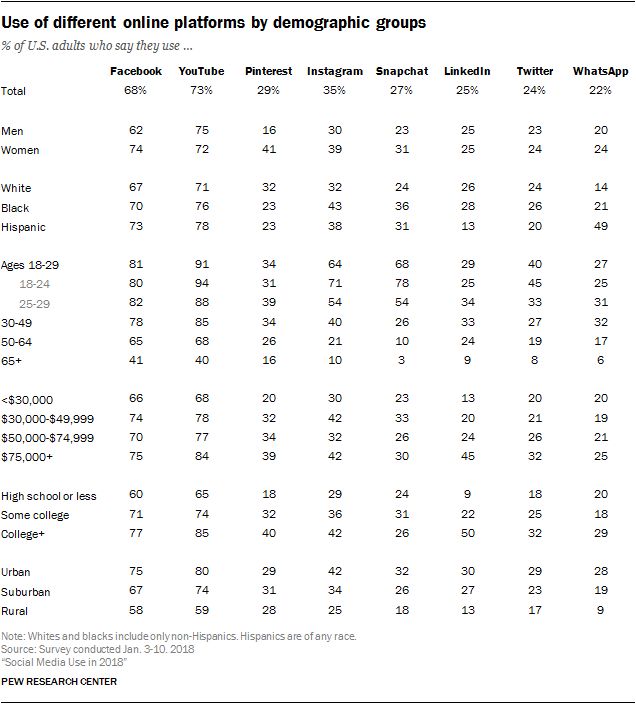
9. Build a Community
If you want to master how to promote your website online, you need to understand the behavior of your audience. Building a community around your brand is probably the best ways to do that. In fact, a community is similar to having a focus group you can ask about anything, at any time. Besides tracking and analyzing behavioral data, having a community can help you upsell products to a loyal customer base, too.
Belonging to a community also adds extra value to your customers. This is especially true if you are running your business in the knowledge industry. Peer advice, new connections, and networking options are deemed extremely valuable nowadays. The feeling of belonging also further increases your customers’ trust in your brand and make them promote your website among their friends. You can run your community on your own website or use external tools such as Facebook or LinkedIn Groups. For example, here is how Moz.com’s SEO community hosted on their own domain looks like:
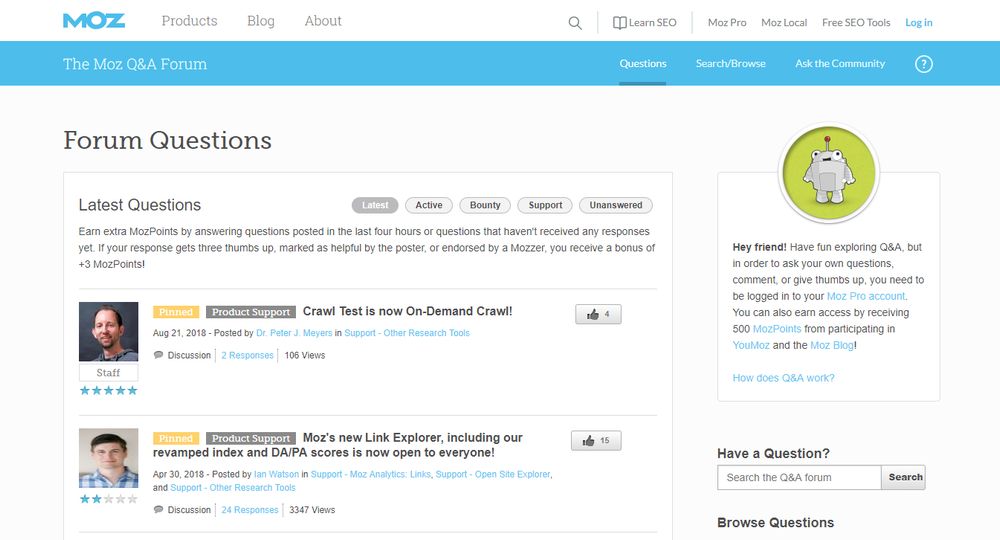
10. Engage Users with Targeted Newsletters
Newsletter campaigns are one of the most popular methods of digital marketing. There are a number of email marketing tools from MailChimp to Email Octopus with which you can automate your campaigns. In recent years, however, people’s mailboxes have become overflown with (often unsolicited) newsletters. Thus, email marketers need to find ways not to be seen as spammers and get the attention of their audience. Segmenting email marketing lists is a proven method to increase open and click rates. Below, you can see the results of MailChimp’s research about the success of segmented newsletter campaigns:
As you can see, segmented newsletter campaigns have much better outcomes in all measured metrics. The 100.95% higher click-through rate is an especially impressive result. Most email marketing tools have built-in list segmentation tools you can access right from their interface. You can segment your email lists based on several criteria, such as:
- demographics,
- engagement rate (e.g. click-through rate, open rate),
- location,
- past behavior (e.g. past purchases, amount spent, date of last purchase),
- personal interests,
- survey results,
- etc.

11. Use Search Engine Advertising
Pay-per-click (PPC) advertising offered by search engines has a number of benefits, both for big and small online businesses. It allows you to decide every aspect of how to promote your website in Google, Bing, or other search engines. You can run a search engine ad campaign even on a minimal budget. The average cost per click in Google Ads is below $1.00, for instance. Because of the low costs, it’s also a good idea to start your campaigns with a sample budget to find out what works and what not for your business.
Search engine advertising platforms, such as Google Ads and Bing Ads, let you target your campaigns based on both audience and content. With audience targeting, you can use demographic and behavioral data to select viewers. On the other hand, with content targeting, you can specify topics, placements, and content keywords to filter users. You can also choose from different ad formats such as text ads, responsive ads, image ads, video ads, and others. The options search engine advertising offers are basically endless. There are several tips you can use to further raise the conversion rates of your campaigns. For example, you can add call-to-actions to your ads, link them to corresponding landing pages, and use specific copywriting techniques as well.
12. Track Performance Statistics
To know how to promote your website online, you need to constantly track the results of your marketing efforts. The web landscape changes incredibly fast and your business needs to adapt to the changing market. The strategy that worked last year won’t necessarily work in the future. To keep the ball rolling, you need to persistently analyze several factors such as:
- which traffic sources bring the most visitors,
- which topics result in the most popular blog posts,
- what keywords bring the most exposure,
- which social media sites you are the most popular on,
- which ad campaigns perform the best,
- where the majority of your visitors are coming from,
- etc.

Luckily, there are several analytic tools you can use to measure the performance of your site. You can add web analytics tools such as Google Analytics to your website with a single script. They allow you to track user demographics, location, behavior, activity, bounce rates, referral traffic, and other data.
You can also use the analytics tools of social media sites to measure the success of your social media campaigns. SEO auditing tools such as SEOptimer can help you analyze your search engine strategy as well.
Wrapping Up
It takes a lot of effort and dedication to figure out how to promote your website online. You need to gather knowledge on your visitors’ behavior, follow trends, produce quality content, run ad and newsletter campaigns, build a loyal follower base, and more. The right tools and techniques can help you achieve your digital marketing goals. As you understand your position in the market and your opportunities, you can constantly adjust your marketing strategy to get the best results.










